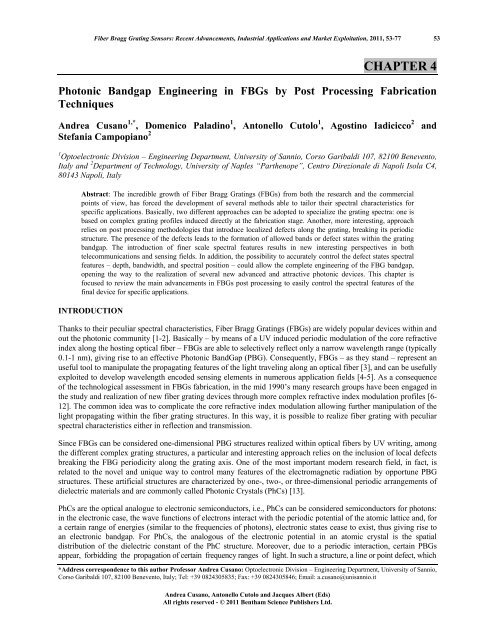chapter 1 - Bentham Science
chapter 1 - Bentham Science
chapter 1 - Bentham Science
Create successful ePaper yourself
Turn your PDF publications into a flip-book with our unique Google optimized e-Paper software.
Fiber Bragg Grating Sensors: Recent Advancements, Industrial Applications and Market Exploitation, 2011, 53-77 53<br />
Andrea Cusano, Antonello Cutolo and Jacques Albert (Eds)<br />
All rights reserved - © 2011 <strong>Bentham</strong> <strong>Science</strong> Publishers Ltd.<br />
CHAPTER 4<br />
Photonic Bandgap Engineering in FBGs by Post Processing Fabrication<br />
Techniques<br />
Andrea Cusano 1,* , Domenico Paladino 1 , Antonello Cutolo 1 , Agostino Iadicicco 2 and<br />
Stefania Campopiano 2<br />
1 Optoelectronic Division – Engineering Department, University of Sannio, Corso Garibaldi 107, 82100 Benevento,<br />
Italy and 2 Department of Technology, University of Naples “Parthenope”, Centro Direzionale di Napoli Isola C4,<br />
80143 Napoli, Italy<br />
Abstract: The incredible growth of Fiber Bragg Gratings (FBGs) from both the research and the commercial<br />
points of view, has forced the development of several methods able to tailor their spectral characteristics for<br />
specific applications. Basically, two different approaches can be adopted to specialize the grating spectra: one is<br />
based on complex grating profiles induced directly at the fabrication stage. Another, more interesting, approach<br />
relies on post processing methodologies that introduce localized defects along the grating, breaking its periodic<br />
structure. The presence of the defects leads to the formation of allowed bands or defect states within the grating<br />
bandgap. The introduction of finer scale spectral features results in new interesting perspectives in both<br />
telecommunications and sensing fields. In addition, the possibility to accurately control the defect states spectral<br />
features – depth, bandwidth, and spectral position – could allow the complete engineering of the FBG bandgap,<br />
opening the way to the realization of several new advanced and attractive photonic devices. This <strong>chapter</strong> is<br />
focused to review the main advancements in FBGs post processing to easily control the spectral features of the<br />
final device for specific applications.<br />
INTRODUCTION<br />
Thanks to their peculiar spectral characteristics, Fiber Bragg Gratings (FBGs) are widely popular devices within and<br />
out the photonic community [1-2]. Basically – by means of a UV induced periodic modulation of the core refractive<br />
index along the hosting optical fiber – FBGs are able to selectively reflect only a narrow wavelength range (typically<br />
0.1-1 nm), giving rise to an effective Photonic BandGap (PBG). Consequently, FBGs – as they stand – represent an<br />
useful tool to manipulate the propagating features of the light traveling along an optical fiber [3], and can be usefully<br />
exploited to develop wavelength encoded sensing elements in numerous application fields [4-5]. As a consequence<br />
of the technological assessment in FBGs fabrication, in the mid 1990’s many research groups have been engaged in<br />
the study and realization of new fiber grating devices through more complex refractive index modulation profiles [6-<br />
12]. The common idea was to complicate the core refractive index modulation allowing further manipulation of the<br />
light propagating within the fiber grating structures. In this way, it is possible to realize fiber grating with peculiar<br />
spectral characteristics either in reflection and transmission.<br />
Since FBGs can be considered one-dimensional PBG structures realized within optical fibers by UV writing, among<br />
the different complex grating structures, a particular and interesting approach relies on the inclusion of local defects<br />
breaking the FBG periodicity along the grating axis. One of the most important modern research field, in fact, is<br />
related to the novel and unique way to control many features of the electromagnetic radiation by opportune PBG<br />
structures. These artificial structures are characterized by one-, two-, or three-dimensional periodic arrangements of<br />
dielectric materials and are commonly called Photonic Crystals (PhCs) [13].<br />
PhCs are the optical analogue to electronic semiconductors, i.e., PhCs can be considered semiconductors for photons:<br />
in the electronic case, the wave functions of electrons interact with the periodic potential of the atomic lattice and, for<br />
a certain range of energies (similar to the frequencies of photons), electronic states cease to exist, thus giving rise to<br />
an electronic bandgap. For PhCs, the analogous of the electronic potential in an atomic crystal is the spatial<br />
distribution of the dielectric constant of the PhC structure. Moreover, due to a periodic interaction, certain PBGs<br />
appear, forbidding the propagation of certain frequency ranges of light. In such a structure, a line or point defect, which<br />
*Address correspondence to this author Professor Andrea Cusano: Optoelectronic Division – Engineering Department, University of Sannio,<br />
Corso Garibaldi 107, 82100 Benevento, Italy; Tel: +39 0824305835; Fax: +39 0824305846; Email: a.cusano@unisannio.it

















